| Pages:
1
2 |
beta4
Hazard to Self
 
Posts: 56
Registered: 3-2-2019
Member Is Offline
|
|
Making phosphorescent materials
Hi everyone, long time forum reader here that just registered.
I'm writing this post to share the success I've had in making ZnS:Cu, or copper doped zinc sulfide.
It's a phosphor that emits a green light when excited with UV light or an electron beam.
The preparation procedure is here (yes, yet another youtube channel)
https://www.youtube.com/watch?v=NGdVCIGHeQE
Perhaps even more interesting, the preparation procedure that I followed is documented in the book "Inorganic Phosphors" by W. Yen and M. Weber. The
book is quite dry, resembling more a lab notebook, but it contains hundreds of phosphor recipes, and hasn't been mentioned on this forum yet.
|
|
|
XeonTheMGPony
International Hazard
    
Posts: 1640
Registered: 5-1-2016
Member Is Offline
Mood: No Mood
|
|
Very nice video, guy deserves more subs, look forward to see what he does with it.
|
|
|
fusso
International Hazard
    
Posts: 1922
Registered: 23-6-2017
Location: 4 ∥ universes ahead of you
Member Is Offline
|
|
GREAT setup for heating small amount of stuff in inert atmosphere!
|
|
|
beta4
Hazard to Self
 
Posts: 56
Registered: 3-2-2019
Member Is Offline
|
|
I'm glad you liked the video, XeonTheMGPony.
I'm currently waiting for some ITO coated conductive glass to arrive from china. When it arrives, I'll try to make a small EL display and see how it
goes.
fusso, the tube furnace is a design of mine. I've taken inspiration from Doug's Lab furnace, but one main requirement was minimizing cost. To be
honest, I wasn't sure I'd be able to make something as sensitive to impurities as a phosphor, so I was looking for a cheap feasibility check.
Just some more info if someone wants to replicate my setup: I bought 5 quartz tubes from deschem for ~20€, enough fire bricks to make four of these
furnaces for another 5€, and the argon cylinder and regulating valve for 20€ each. I already had the gas torch.
|
|
|
CharlieA
National Hazard
   
Posts: 646
Registered: 11-8-2015
Location: Missouri, USA
Member Is Offline
Mood: No Mood
|
|
If I ever get a "round-2-it", I may try making some to dope alumina or silica gel plates for TLC. Thanks for the link. Charlie
|
|
|
XeonTheMGPony
International Hazard
    
Posts: 1640
Registered: 5-1-2016
Member Is Offline
Mood: No Mood
|
|
What was the IR sensitive phosphor they used for testing remote control IR transmitters?
|
|
|
beta4
Hazard to Self
 
Posts: 56
Registered: 3-2-2019
Member Is Offline
|
|
I recall that some long afterglow phosphors can be "charged" with UV light, and be made to release the stored energy and light up under IR light.
The book I referenced lists one such phosphor: ZnS:Pb,Cu
The preparation is very similar to the one in my video (inert atmosphere, 1100°C firing temperature), but requires to add ~1.65mg of lead nitrate
instead of the ammonium chloride.
I also found (in the same book) a few "upconversion" phosphors able to convert infrared to visible, but don't seem very amateur friendly to make. One
is made of 25% molar ErCl3, the rest being BaCl2, but is hygroscopic and destroyed by moisture. The others are even worse as are based on fluorides.
[Edited on 4-2-2019 by beta4]
|
|
|
Ozone
International Hazard
    
Posts: 1269
Registered: 28-7-2005
Location: Good Olde USA
Member Is Offline
Mood: Integrated
|
|
Interesting stuff, that. I've attached a .pdf demonstrating the properties of commercial pumped IR phosphors. It doesn't provide any compositional
information, but does show what you can get out of them. Also, they rotate the stuff in the beam to minimize saturation.
O3
Attachment: Low-Cost IR Visualizer.pdf (416kB)
This file has been downloaded 645 times
-Anyone who never made a mistake never tried anything new.
--Albert Einstein
|
|
|
Heptylene
Hazard to Others
  
Posts: 319
Registered: 22-10-2016
Member Is Offline
Mood: No Mood
|
|
Great results!
|
|
|
Bezaleel
Hazard to Others
  
Posts: 444
Registered: 28-2-2009
Member Is Offline
Mood: transitional
|
|
Thanks for posting this!
I wonder why the argon shield works at all, because I would think that through diffusion, the argon will escape. That the argon is heavier than air
doesn't matter too much when it comes to inhibiting diffusion. At least, that's my experience with diffusion. (And I didn't see you close the ends of
the tubes attached to the quartz heating tube.)
Does it boil down to a matter of good timing? I.e. the diffusion speed being slow enough to allow for 10 minutes of heating without the copper
oxidising?
|
|
|
beta4
Hazard to Self
 
Posts: 56
Registered: 3-2-2019
Member Is Offline
|
|
From what I read, doping of crystalline materials is affected by the atmosphere used during the reaction.
In the phosphors book, each phosphor recipe includes an atmosphere recommendation.
Some recipes just say to do the firing in air, so I guess that if any other atmosphere is recommended, there has to be a reason.
However, it may not mean that it absolutely does not work unless the proper atmosphere is used.
This leaves two possibilities:
- either the small openings of the tube coupled with the fact that the firing is done immediately after the Ar filling limits diffusion
- or a little bit (or a lot) of air does not affect the preparation of ZnS:Cu
- or both
To know for sure we need a phosphor that absolutely does not work when fired in air, but works when fired with the tube filled with Ar in the way I've
done so far.
I may have a good candidate, but no promises on when I can do the tests (I'm busy with my day job).
|
|
|
Tsjerk
International Hazard
    
Posts: 3032
Registered: 20-4-2005
Location: Netherlands
Member Is Offline
Mood: Mood
|
|
Very nice video!
I do think you are a bit hard to understand when you are standing in a certain position compared to your camera, sometimes it is fine, sometimes you
sound different. It may be worse when you stand behind your camera, or maybe it is the distance.
But keep up the videos, I at least subscribed.
|
|
|
stibium
Harmless

Posts: 7
Registered: 9-12-2015
Member Is Offline
Mood: No Mood
|
|
Hi everyone,
I have had some success synthesizing phosphorescent materials based on alkaline earth sulfides and zinc sulfide.
I synthesized the sulfide according to the chemical reaction:
2 MCO3 + 3 S = 2 MS + SO2 + 2 CO2
M = Ca, Sr, Ba or Zn
It is also possible with this other reaction:
4 MO + 4 S = 3 MS + MSO4
Phosphorescence is achieved by adding very small amounts of some metal that acts as an activator (Cu, Bi, Ag, Eu ...). The activator metal is added in
the form of a salt dissolved in water (I used nitrates). I prepared very dilute solutions and added the necessary amount of activator according to
each recipe. I used the amounts of activator described in these articles:
Alkaline earth sulfide phosphorescent pigments: https://patents.google.com/patent/US2544507
Calcium sulfide Europium doped: https://www.researchgate.net/publication/244688077_Enhanceme...
"Inorganic Phosphors" by W. Yen and M. Weber
It is also necessary to add a small amount of a low melting point salt (flux), which serves to distribute the activator more evenly in the sulfide. I
mainly use Na2SO4 and NaCl as fluxes, but Na2CO3 can also work.
Basically I followed this procedure:
I made a suspension in water by intimately mixing the alkaline earth carbonate, sulfur, flux and the activator salt (drops of solution). I heated this
mix to evaporate the water, and put the dry mix into a covered crucible placed on a gas burner for 30 minutes, or until the evolution of gas ceases.
Then I placed the crucible covered in an electric oven maintained for 30 minutes at 950ºC. Then I took it out to cool down quickly.
There are a number of rules to follow to be successful:
It has to start from very pure chemicals. Iron is a phosphorescence killer, amounts of even one part per million damage phosphorescence.
The amount of activator must be very small.
The mixture of all the products must be very intimate and uniform.
The crucible must be covered to avoid oxidation of the sulfide by air. The ideal would be to heat the products in a reducing atmosphere (sulfur vapor,
SH2, or CS2).
The calcination temperature should be high but not excessive (900 to 1000 ºC).
Once the phosphorescent material has been obtained, it must be kept in tightly closed containers. CaS, SrS and BaS are chemically unstable in
atmosphere. With moisture in air, these three compounds will be degraded and release SH2.
Phosphorescence can be activated by daylight, UV light, or a white LED flashlight in less than 1 minute. and the duration of the phosphorescence is
between 30 minutes and several hours (depending on each case).
Pictures:
From left to right:
SrS:Eu
CaS:Eu,Ce,Tm
SrS:Bi
CaS:Bi,Ag
ZnS:Cu
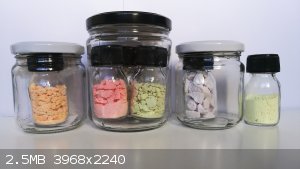 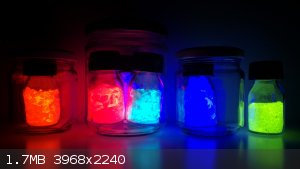 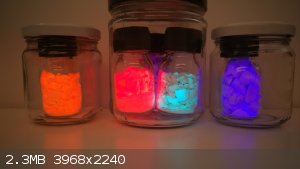
|
|
|
Bedlasky
International Hazard
    
Posts: 1239
Registered: 15-4-2019
Location: Period 5, group 6
Member Is Offline
Mood: Volatile
|
|
Stibium: Very nice results! I recently read about Ln3+/Yb3+ dopped CaWO4 phosphors and I plan to make these.
|
|
|
Bezaleel
Hazard to Others
  
Posts: 444
Registered: 28-2-2009
Member Is Offline
Mood: transitional
|
|
Great work, stibium! I love phosphors, but I cannot make them because I do not have a furnace. The ones in your pictures are fantastic.
|
|
|
vano
National Hazard
   
Posts: 661
Registered: 22-3-2019
Location: Georgia
Member Is Offline
|
|
I bought a samarium today. I am going to use it in other things, but if you have information on how to make a similar material with samarium, I would
be happy to try it.
|
|
|
ChemTalk
Hazard to Self
 
Posts: 65
Registered: 13-12-2018
Location: United States
Member Is Offline
Mood: colloidal
|
|
Stibium, thanks so much for posting your report and the links to the articles. These are the best results I've seen from this procedure which is known
to be difficult. Will you try any more combinations?
Vano, I look forward to seeing what you make with your samarium.
|
|
|
vano
National Hazard
   
Posts: 661
Registered: 22-3-2019
Location: Georgia
Member Is Offline
|
|
I am mainly interested in divalent compounds. Unlike other lanthanides this compounds are stable.
[Edited on 23-1-2021 by vano]
|
|
|
Bedlasky
International Hazard
    
Posts: 1239
Registered: 15-4-2019
Location: Period 5, group 6
Member Is Offline
Mood: Volatile
|
|
Vano: I wouldn't say that Sm(II) is stable (at least in aqueous solution). It's very strong reducing agent, it's impossible to make it in aqueous
solution because it reacts with water, you must work in THF. It can be easily make by reaction between metallic Sm and I2 in THF. There are more
solvents for SmI2 than THF. YbI2 can be made similarly. Both compounds have similar properties, but because SmI2 is less stable, it have stronger
reducing properties and it work better than YbI2. I send you some materials about SmI2 and YbI2 in U2U. I discussed lanthanide chemistry with Fery
recently and we talked about using SmI2 in organic reactions.
Btw: Not just samarium is stable in II oxidation state. Ytterbium and europium are even more stable (Eu(II) can be made even in aqueous solution).
[Edited on 24-1-2021 by Bedlasky]
|
|
|
beta4
Hazard to Self
 
Posts: 56
Registered: 3-2-2019
Member Is Offline
|
|
Nice phosphors stibium!
I'm going back to making phosphors as well. After finding a way to purify sulfur and silver I finally made ZnS:Ag with an acceptable brightness (will
make a video about it soon).
I also ordered SrCO3, Pr(NO3)3, TiO2 to try making some red phosphorescent materials (SrTiO3 : Pr3+ from the book Inorganic
Phosphors). After that, I'll try mixing them to get white, which seems something you can already try.
[Edited on 24-1-2021 by beta4]
[Edited on 24-1-2021 by beta4]
|
|
|
stibium
Harmless

Posts: 7
Registered: 9-12-2015
Member Is Offline
Mood: No Mood
|
|
Quote: Originally posted by ChemTalk  | Stibium, thanks so much for posting your report and the links to the articles. These are the best results I've seen from this procedure which is known
to be difficult. Will you try any more combinations?
Vano, I look forward to seeing what you make with your samarium. |
I have synthesized another phosphorescent material:
BaS: Bi (golden yellow phosphorescence)
right: CaS: Bi
behind: SrS: Bi
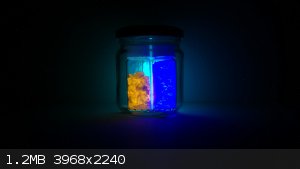
|
|
|
stibium
Harmless

Posts: 7
Registered: 9-12-2015
Member Is Offline
Mood: No Mood
|
|
Quote: Originally posted by vano  | | I bought a samarium today. I am going to use it in other things, but if you have information on how to make a similar material with samarium, I would
be happy to try it. |
I found 2 articles about use of samarium in some phosphorescent materials:
https://www.sciencedirect.com/science/article/abs/pii/S00222...
https://www.sciencedirect.com/science/article/abs/pii/S00222...
A possible use of samarium in pyrotechnics:
Samarium powder sprayed over a flame produces pink sparks.
Here you can see 2 interesting articles about colored sparks with samarium and other rare earth metals:
http://pyrobin.com/files/Sparks.pdf
http://pyrobin.com/files/Sparks2.pdf
Here you can find many scientific articles on phosphorescent materials, synthesis, properties, uses ...
https://www.sciencedirect.com/journal/journal-of-luminescenc...
|
|
|
RustyShackleford
Hazard to Others
  
Posts: 200
Registered: 10-12-2020
Location: Northern Europe
Member Is Offline
|
|
Nowhere near the quality of the stuff stibium produced but this is something i made. Using same method as beta4:s linked video, but torched in a tube
and wihout protective atmosphere
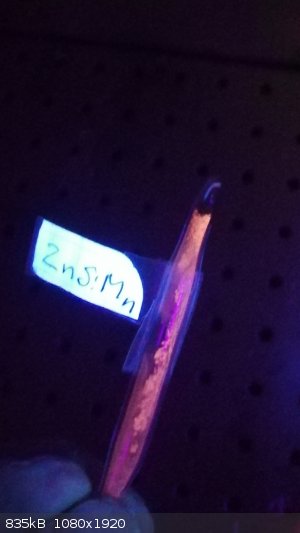
[Edited on 24-1-2021 by RustyShackleford]
|
|
|
vano
National Hazard
   
Posts: 661
Registered: 22-3-2019
Location: Georgia
Member Is Offline
|
|
Thank you stibium
|
|
|
beta4
Hazard to Self
 
Posts: 56
Registered: 3-2-2019
Member Is Offline
|
|
Quote: Originally posted by RustyShackleford  | | Nowhere near the quality of the stuff stibium produced but this is something i made. Using same method as beta4:s linked video, but torched in a tube
and wihout protective atmosphere] |
ZnS:Mn in my experience is one of the hardest. Likely because of Fe impurities in Mn which are very hard to get rid of. The optimal concentration of
Mn is also much higher than Cu or Ag, around 1% molar, so you're adding even more Fe to the mix.
The best attempt I made is still much dimmer than ZnS:Cu and the powder is visibly textured with bright and dark spots, unlike the copper and silver
ones which are uniformly bright.
My advice since you already have the setup to make phosphors is to try again with copper, you won't regret it.
|
|
|
| Pages:
1
2 |